A Digital Twin of Hot Pumping Waxy Oil Through a Main Pipeline
Abstract
1. Introduction
2. Digital Twin of Waxy Oil Hot Pumping
2.1. Structure
2.2. Digital Duplicates of Original Data
2.2.1. Digitalization of Equipment Characteristics at Stations
2.2.2. Digitalization of Hydraulic Parameters and Heat Transfer of the Pipeline
3. SmartTranPro 1.7.1 Software
3.1. System of Equations of Motion and Heat Transfer in the Pipeline’s Linear Part
3.2. Closing Conditions
3.3. Optimization Criterion
3.4. The Integration of SmartTran Software with SCADA and ECMAS
3.5. SmartTran Software Modules
- Module for the thermal–hydraulic calculations of the stationary and non-stationary modes of waxy oil hot pumping;
- Module for identifying the pressure–volume characteristics and the efficiency of the pumping units depending on their service life;
- Module for identifying the efficiency of the heating furnaces depending on their service life;
- Module for identifying the hydraulic resistance of the pipelines, taking into account changes in pipe roughness;
- Module for identifying the thermal conductivity coefficient of the soil.
4. Discussion
4.1. Calculated Pressure and Temperature Data
4.2. Waxy Oil Heating Temperature Optimization
5. Conclusions
Author Contributions
Funding
Data Availability Statement
Conflicts of Interest
References
- Javaid, M.; Haleem, A.; Suman, R. Digital Twin applications toward Industry 4.0: A Review. Cogn. Robot. 2023, 3, 71–92. [Google Scholar] [CrossRef]
- Aheleroff, S.; Zhong, R.Y.; Xu, X. A digital twin reference for mass personalization in industry 4.0. Procedia Cirp. 2020, 93, 228–233. [Google Scholar] [CrossRef]
- Guerra-Zubiaga, D.; Kuts, V.; Mahmood, K.; Bondar, A.; Nasajpour-Esfahani, N.; Otto, T. An approach to develop a digital twin for industry 4.0 systems: Manufacturing automation case studies. Int. J. Comput. Integr. Manuf. 2021, 34, 933–949. [Google Scholar] [CrossRef]
- Assawaarayakul, C.; Srisawat, W.; Ayuthaya, S.D.N.; Wattanasirichaigoon, S. Integrate digital twin to exist production system for industry 4.0. In Proceedings of the 4th Technology Innovation Management and Engineering Science International Conference (TIMES-iCON), Bangkok, Thailand, 11–13 December 2019. [Google Scholar] [CrossRef]
- Uhlemann, T.H.J.; Lehmann, C.; Steinhilper, R. The digital twin: Realizing the cyber-physical production system for industry 4.0. Procedia Cirp. 2017, 61, 335–340. [Google Scholar] [CrossRef]
- Qi, Q.; Tao, F. Digital twin and big data towards smart manufacturing and industry 4.0: 360 degree comparison. IEEE Access 2018, 6, 3585–3593. [Google Scholar] [CrossRef]
- Vachálek, J.; Bartalský, L.; Rovný, O.; Šišmišová, D.; Morháč, M.; Lokšík, M. The digital twin of an industrial production line within the industry 4.0 concept. In Proceedings of the 21st International Conference on Process Control (PC), Strbske Pleso, Slovakia, 6–9 June 2017. [Google Scholar] [CrossRef]
- Pires, F.; Cachada, A.; Barbosa, J.; Moreira, A.P.; Leitão, P. Digital twin in industry 4.0: Technologies, applications and challenges. In Proceedings of the 17th International Conference on Industrial Informatics (INDIN), Helsinki, Finland, 22–25 July 2019. [Google Scholar] [CrossRef]
- Durão, L.F.; Haag, S.; Anderl, R.; Schützer, K.; Zancul, E. Digital twin requirements in the context of industry 4.0. In Proceedings of the IFIP International Conference on Product Lifecycle Management, Turin, Italy, 2–4 July 2018. [Google Scholar] [CrossRef]
- Aheleroff, S.; Xu, X.; Zhong, R.Y.; Lu, Y. Digital twin as a service (DTaaS) in industry 4.0: An architecture reference model. Adv. Eng. Inform. 2021, 47, 101225. [Google Scholar] [CrossRef]
- Nguyen, H.X.; Trestian, R.; To, D.; Tatipamula, M. Digital twin for 5G and beyond. IEEE Commun. Mag. 2021, 59, 10–15. [Google Scholar] [CrossRef]
- Agnusdei, G.P.; Elia, V.; Gnoni, M.G. Is digital twin technology supporting safety management? A bibliometric and systematic review. Appl. Sci. 2021, 11, 2767. [Google Scholar] [CrossRef]
- Qazi, A.M.; Mahmood, S.H.; Haleem, A.; Bahl, S.; Javaid, M.; Gopal, K. The impact of smart materials, digital twins (DTs) and Internet of things (IoT) in an Industry 4.0 integrated automation industry. Mater. Today Proc. 2022, 6, 18–25. [Google Scholar] [CrossRef]
- Fuller, A.; Fan, Z.; Day, C.; Barlow, C. Digital twin: Enabling technologies, challenges and open research. IEEE Access 2020, 8, 108952–108971. [Google Scholar] [CrossRef]
- Martínez-Gutiérrez, A.; Díez-González, J.; Ferrero-Guillén, R.; Verde, P.; Álvarez, R.; Perez, H. Digital twin for automatic transportation in industry 4.0. Sensors 2021, 21, 3344. [Google Scholar] [CrossRef] [PubMed]
- Hinduja, H.; Kekkar, S.; Chourasia, S.; Chakrapani, H.B. Industry 4.0: Digital twin and its industrial applications. Int. J. Eng. Sci. Tech. 2020, 8, 1–7. [Google Scholar]
- Rolle, R.; Martucci, V.; Godoy, E. Architecture for Digital Twin implementation focusing on Industry 4.0. IEEE Lat. Am. Tran. 2020, 18, 889–898. [Google Scholar] [CrossRef]
- Barykin, S.Y.; Bochkarev, A.A.; Kalinina, O.V.; Yadykin, V.K. Concept for a supply chain digital twin. Int. J. Math. Eng. Manag. Sci. 2020, 5, 1498–1515. [Google Scholar] [CrossRef]
- Židek, K.; Piteľ, J.; Adámek, M.; Lazorík, P.; Hošovský, A. Digital twin of experimental smart manufacturing assembly system for industry 4.0 concept. Sustainability 2020, 12, 3658. [Google Scholar] [CrossRef]
- Kholopov, V.A.; Antonov, S.V.; Kashirskaya, E.N. Application of the digital twin concept to solve the monitoring task of machine-building technological process. In Proceedings of the International Russian Automation Conference (RusAutoCon), Sochi, Russia, 8–14 September 2019. [Google Scholar] [CrossRef]
- Papacharalampopoulos, A.; Stavropoulos, P.; Petrides, D. Towards a digital twin for manufacturing processes: Applicability on laser welding. Procedia Cirp. 2020, 88, 110–115. [Google Scholar] [CrossRef]
- Sajid, S.; Haleem, A.; Bahl, S.; Javaid, M.; Goyal, T.; Mittal, M. Data science applications for predictive maintenance and materials science in context to Industry 4.0. Mater. Today Proc. 2021, 45, 4898–4905. [Google Scholar] [CrossRef]
- Hearn, M.; Rix, S. Cybersecurity considerations for digital twin implementations. IIC J. Innov. 2019, 10, 107–113. [Google Scholar]
- Lee, J.; Azamfar, M.; Singh, J.; Siahpour, S. Integration of digital twin and deep learning in cyber-physical systems: Towards smart manufacturing. IET Coll. Intel. Manuf. 2020, 2, 34–36. [Google Scholar] [CrossRef]
- Jiang, Z.; Guo, Y.; Wang, Z. Digital twin to improve the virtual-real integration of industrial IoT. J. Ind. Inf. Integr. 2021, 22, 100196. [Google Scholar] [CrossRef]
- Negri, E.; Fumagalli, L.; Cimino, C.; Macchi, M. FMU-supported simulation for CPS digital twin. Procedia manuf. 2019, 28, 201–206. [Google Scholar] [CrossRef]
- Tao, F.; Zhang, M. Digital twin shop-floor: A new shop-floor paradigm towards smart manufacturing. IEEE Access 2017, 5, 20418–20427. [Google Scholar] [CrossRef]
- Negri, E.; Fumagalli, L.; Macchi, M. A review of the roles of digital twin in CPS-based production systems. Procedia Manuf. 2017, 11, 939–948. [Google Scholar] [CrossRef]
- Pang, T.Y.; Pelaez Restrepo, J.D.; Cheng, C.T.; Yasin, A.; Lim, H.; Miletic, M. Developing a digital twin and digital thread framework for an ‘Industry 4.0’ Shipyard. Appl. Sci. 2021, 11, 1097. [Google Scholar] [CrossRef]
- Schroeder, G.N.; Steinmetz, C.; Rodrigues, R.N.; Henriques, R.V.B.; Rettberg, A.; Pereira, C.E. A methodology for digital twin modeling and deployment for industry 4.0. Proc. IEEE 2020, 109, 556–567. [Google Scholar] [CrossRef]
- Priyanka, E.B.; Thangavel, S.; Gao, X. Review analysis on cloud computing based smart grid technology in the oil pipeline sensor network system. Pet. Res. 2021, 6, 77–90. [Google Scholar] [CrossRef]
- Nikuradse, J. Regularity of turbulent flow in smooth pipes. In Problem of Turbulence; ONTI NKTP SSSR: Moscow, Russia; Saint Petersburg, Russia, 1936; pp. 75–150. (In Russian) [Google Scholar]
- Schlikhting, G. Theory of Boundary-Layer; Nauka: Moscow, Russia, 1974. (In Russian) [Google Scholar]
- Colebrook, C.F.; White, C.M. Experiments with fluid friction in roughened pipes. Proc. R. Soc. Lond. Ser. A Math. Phys. Sci. 1937, 161, 367–381. [Google Scholar] [CrossRef]
- Altshul, A.D. Hydraulic Resistance; Nedra: Moscow, Russia, 1982. (In Russian) [Google Scholar]
- Bekibayev, T.; Zhapbasbayev, U.; Ramazanova, G.; Bossinov, D.; Pham, D.T. Oil pipeline hydraulic resistance coefficient identification. Cogent Eng. 2021, 8, 1950303. [Google Scholar] [CrossRef]
- Kondratev, A.S.; Nha, T.L.; Shvydko, P.P. The Colebrook-White general formulas pipe flow for arbitrary sand roughnees of pipe wall. Fundam. Res. 2017, 1, 74–78. [Google Scholar]
- Bekibayev, T.T.; Ramazanova, G.I.; Pakhomov, M.A. The problem of optimizing pumping units for oil transportation. Compl. Use of Min. Resour. 2022, 321, 38–46. [Google Scholar] [CrossRef]
- Beysembetov, I.K.; Bekibayev, T.T.; Zhapbasbayev, U.K.; Ramazanova, G.I.; Panfilov, M. SmartTran Software for transportation of oil JSC KazTransOil. News NAS RK. Ser. Geol. Tech. Sci. 2020, 2, 6–13. [Google Scholar] [CrossRef]
- Bekibayev, T.T.; Zhapbasbayev, U.K.; Ramazanova, G.I. Optimal regimes of heavy oil transportation through a heated pipeline. J. Process Control. 2022, 115, 27–35. [Google Scholar] [CrossRef]
- Garris, N.A.; Rusakov, A.I.; Baykova, L.R. New approach to estimation of thermal conductivity coefficient for underground pipeline forming a thawing halo in permafrost. J. Phys. 2018, 1111, 012016. [Google Scholar] [CrossRef]

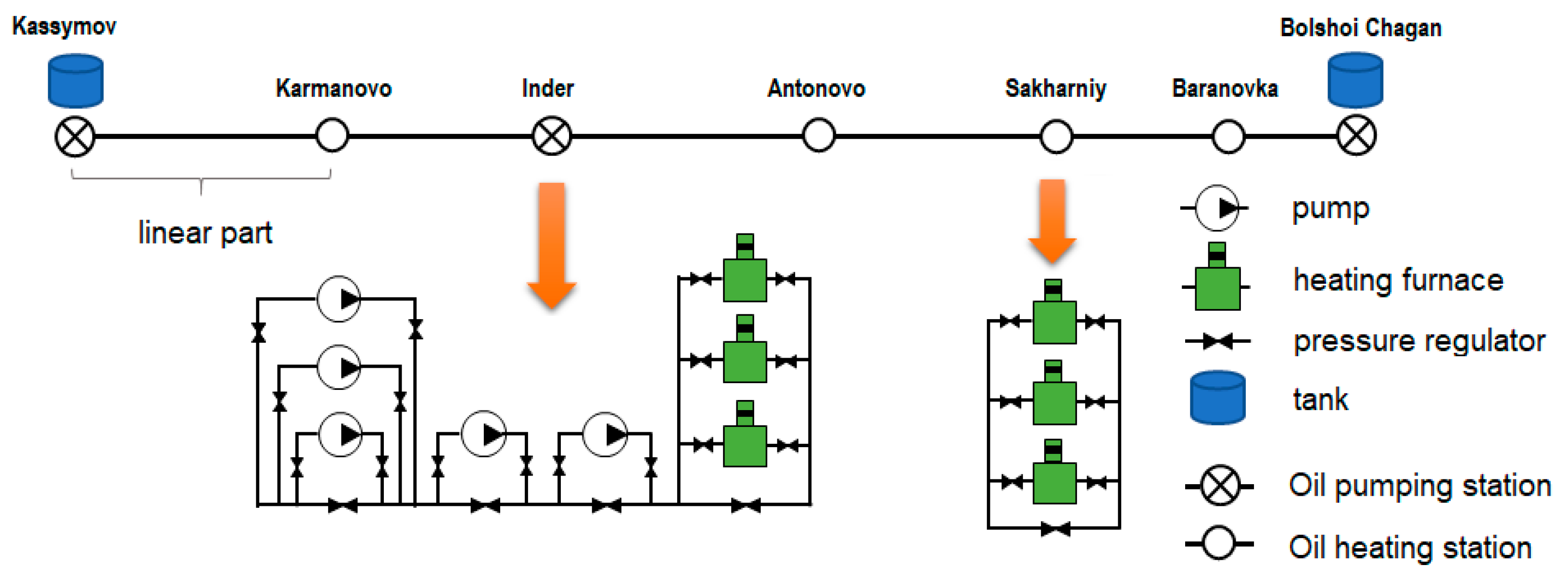
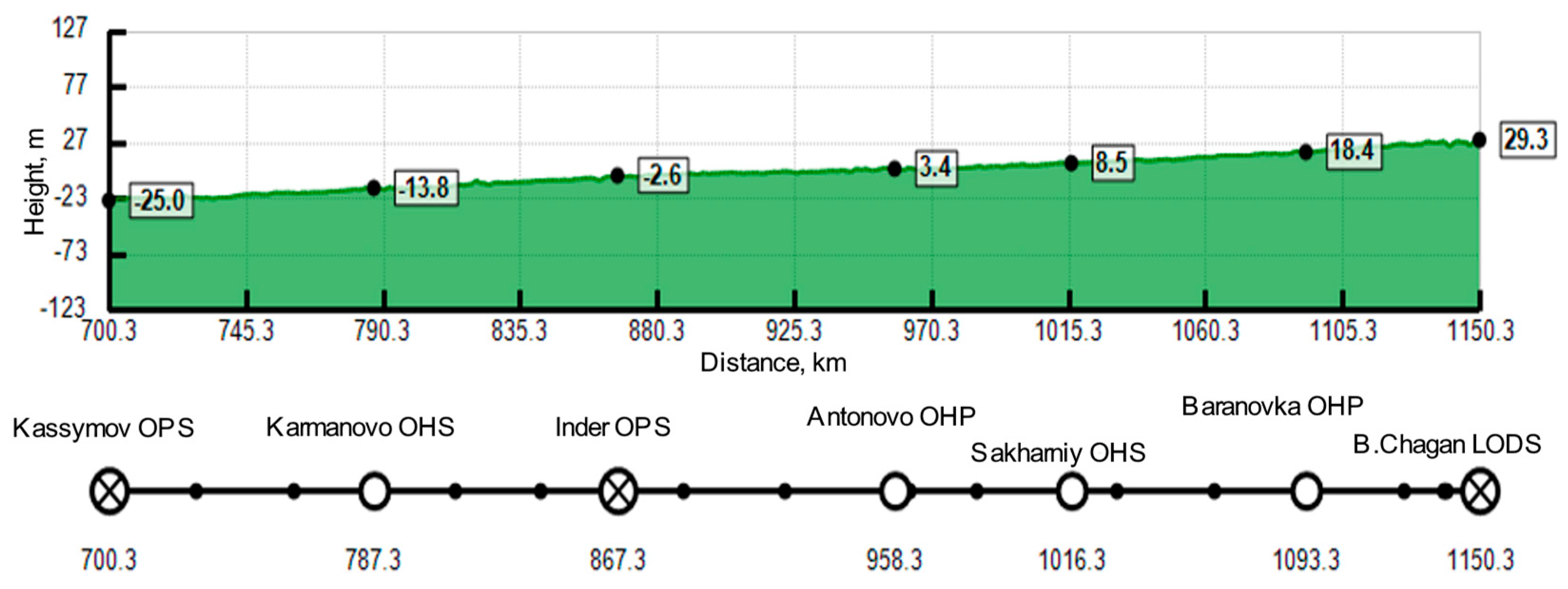
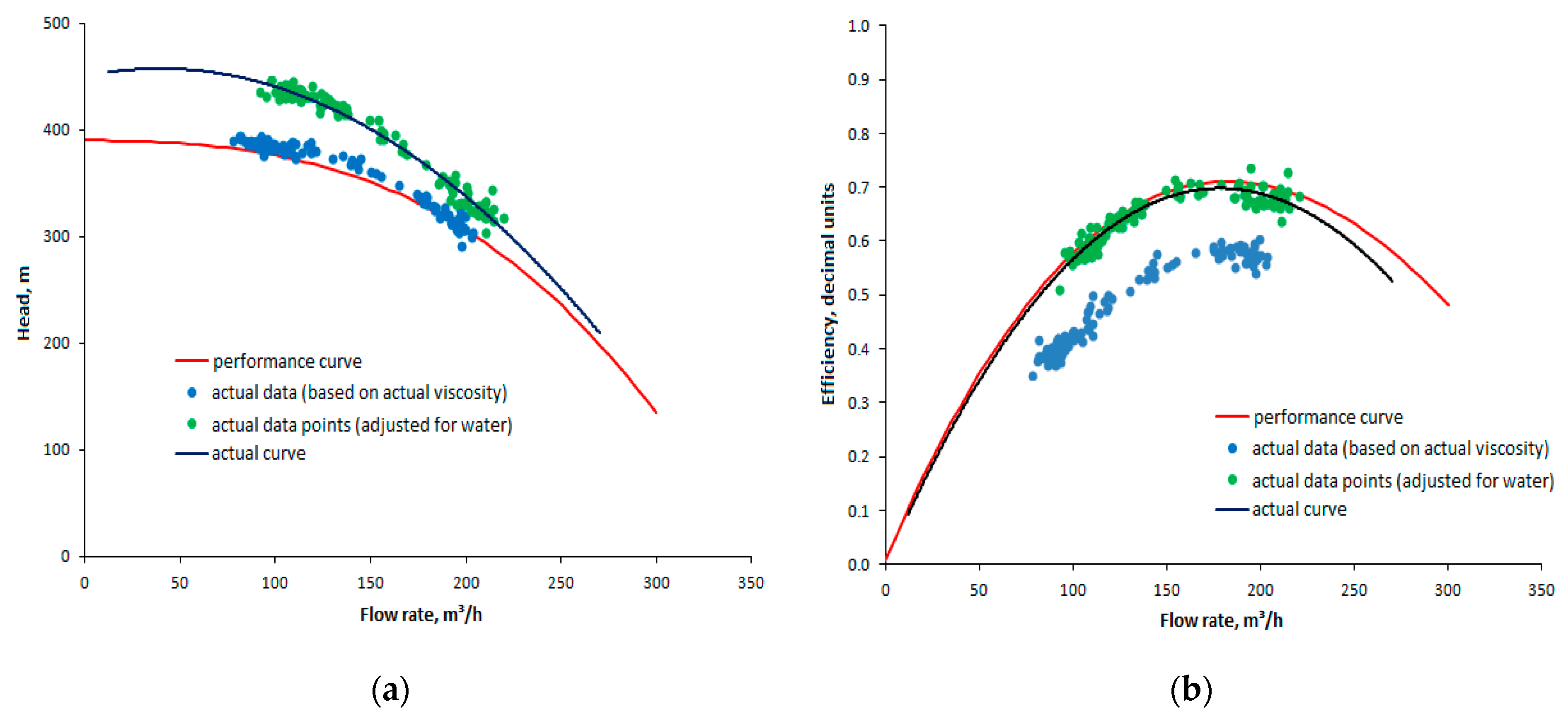

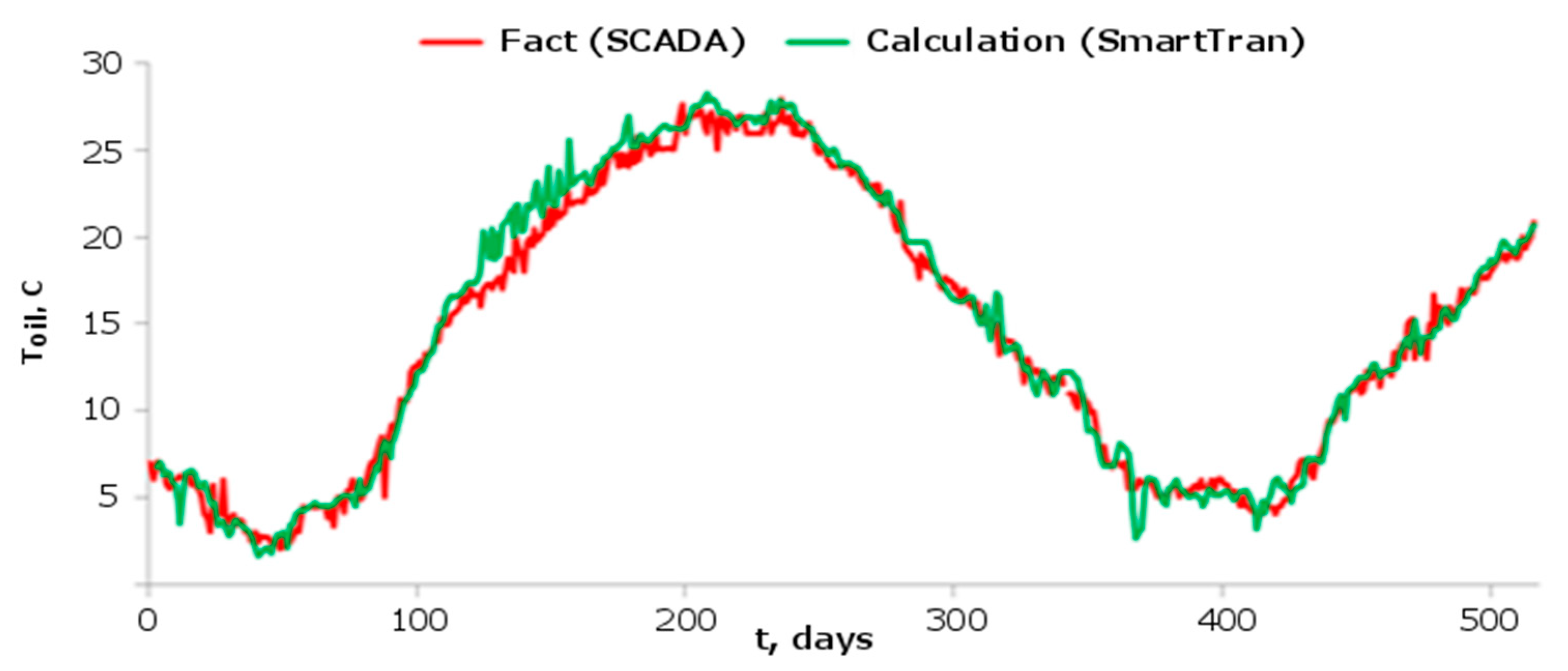
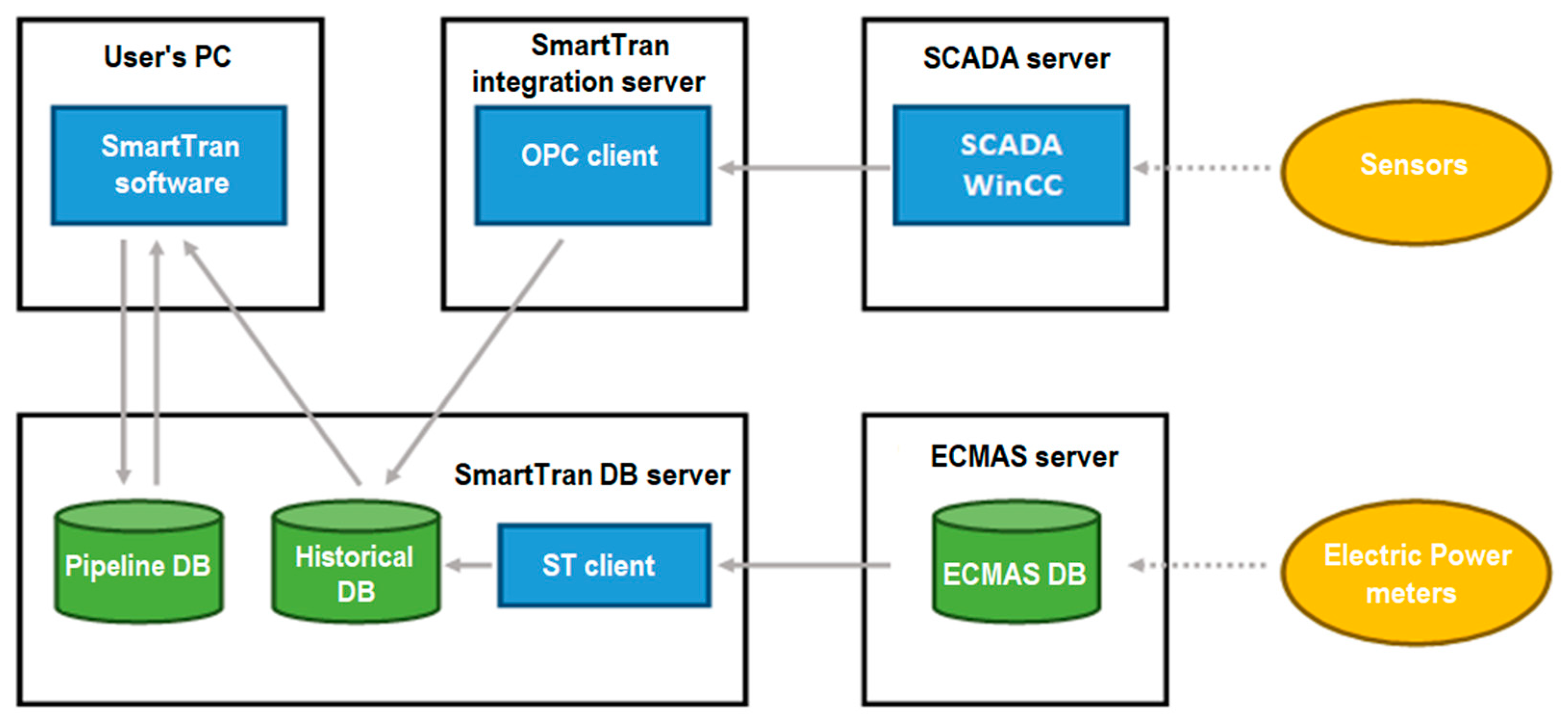


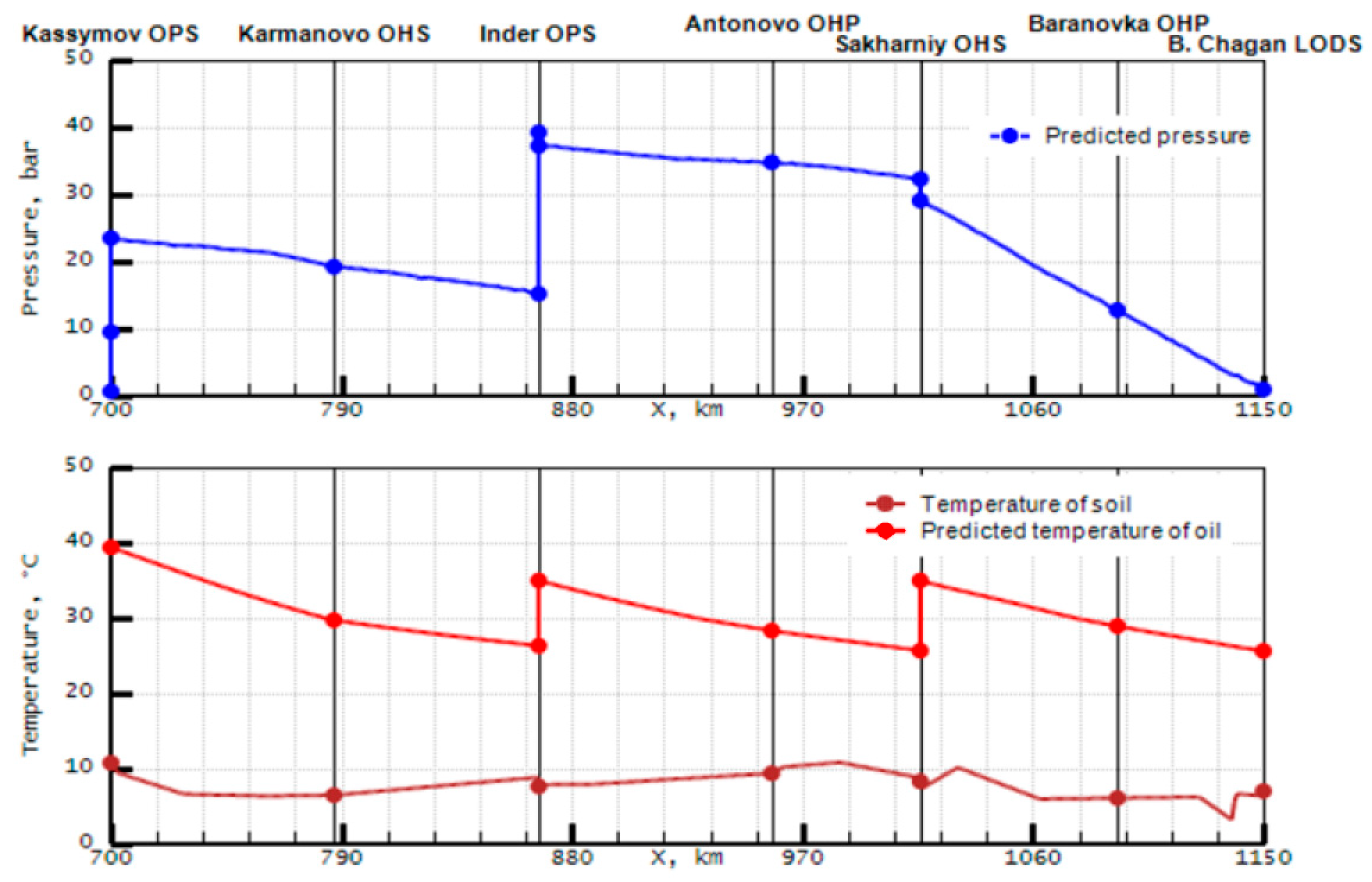
Disclaimer/Publisher’s Note: The statements, opinions and data contained in all publications are solely those of the individual author(s) and contributor(s) and not of MDPI and/or the editor(s). MDPI and/or the editor(s) disclaim responsibility for any injury to people or property resulting from any ideas, methods, instructions or products referred to in the content. |
© 2025 by the authors. Licensee MDPI, Basel, Switzerland. This article is an open access article distributed under the terms and conditions of the Creative Commons Attribution (CC BY) license (https://creativecommons.org/licenses/by/4.0/).
Share and Cite
Zhapbasbayev, U.; Bekibayev, T.; Ramazanova, G.; Akasheva, Z. A Digital Twin of Hot Pumping Waxy Oil Through a Main Pipeline. Energies 2025, 18, 202. https://doi.org/10.3390/en18010202
Zhapbasbayev U, Bekibayev T, Ramazanova G, Akasheva Z. A Digital Twin of Hot Pumping Waxy Oil Through a Main Pipeline. Energies. 2025; 18(1):202. https://doi.org/10.3390/en18010202
Chicago/Turabian StyleZhapbasbayev, Uzak, Timur Bekibayev, Gaukhar Ramazanova, and Zhibek Akasheva. 2025. "A Digital Twin of Hot Pumping Waxy Oil Through a Main Pipeline" Energies 18, no. 1: 202. https://doi.org/10.3390/en18010202
APA StyleZhapbasbayev, U., Bekibayev, T., Ramazanova, G., & Akasheva, Z. (2025). A Digital Twin of Hot Pumping Waxy Oil Through a Main Pipeline. Energies, 18(1), 202. https://doi.org/10.3390/en18010202




